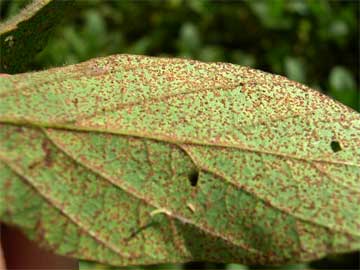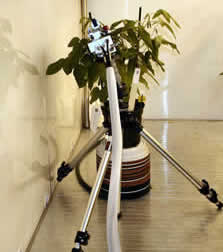Yield Loss Prediction Tool for Field-Specific Risk Management of Asian Soybean Rust
Introduction
Asian soybean rust pathogen (SBR) is a serious threat to soybean production since its arrival in the United States. This pathogen has the potential to reduce crop yields by as much as 80%.
Project Summary
Our lab is leading an international, multidisciplinary project to develop a yield loss prediction model for Asian soybean rust. The ultimate aim of this study funded by the Risk Management Agency is to develop an interactive software tool that would determine the farmer’s current yield potential and the yield loss predicted if SBR should defoliate the crop. The potential yield loss could be weighed against the cost of the fungicide application to make sound management decisions.
For more information:
Use of Vegetative Index to Determine Potential Yield Loss: A Risk Management Tool for Asian Soybean Rust
Introduction
Soybean rust is a fungal disease that can completely defoliate a soybean plant causing major yield losses. Yield loss due to defoliating pest is frequently associated with changes in leaf area. However, measurement of leaf area is complex and generally destructive.
Project Summary
The objective of the current study is to develop a relationship between leaf area and NDVI, a non-destructive measure of canopy density. It was found that the NDVI values were better correlated with leaf area under wide rows than under narrow rows.
The Impact of Soybean Rust On Leaf Photosynthetic Rate
Introduction
The production potential of a crop is related to amount of radiant energy intercepted by the crop and efficiency with which that radiant energy is converted to biomass.
Project Summary
The objective of the current study is to determine the impact of Asian soybean rust on leaf production potential. We used two cultivars, susceptible and resistant to SBR. They were treated with different inoculation rates. Measurement of net photosynthetic rate was taken with LED light source of portable photosynthesis system (LI-6400, LI-Cor).
Genetic and Photoperiodic Control of Soybean Reproductive Phase
Introduction
The duration of the reproductive phase is critical to soybean yield. Understanding the mechanisms that control this phase can help tailor soybean cultivars to their environment and thus improve yield.
Project Summary
The objective of the current study was to determine the role of photoperiod and E-genes on the duration of the reproductive phase in soybean. It was found that photoperiod extension, either artificially or by early planting, significantly increased the duration of the reproductive phase in NILs with dominant alleles. E-genes impact the duration of the soybean reproductive phase. Dominant E-gene alleles extend the duration of the reproductive phase in a photoperiod-mediated response.
For more information:
- 2006 ASA presentation poster (pdf)
Influence of E-Genes on Onset and Rate of Leaf Senescence in Near Isogenic Lines of Soybean
Introduction
Genetic improvement in yield of a number of crops species including soybean has been associated with delayed senescence, i.e., the ‘stay-green‘ characteristic. The current study explores the impact of a group of developmental genes, known as the E-gene series, on soybean leaf senescence.
Project Summary
It was found that the presence of the dominant E1 allele significantly delayed the onset of functional senescence post-flowering, under both photoperiod treatments tested. This delay in senescence may be directly or indirectly related to the impact of this gene on reproductive development. The microarray data revealed a large number of differentially expressed genes that will likely hold further information on this phenomenon.
For more information:
- 2006 ASA presentation poster (pdf)
Effect of the E1 Allele on Reproductive Development In Glycine Max
Introduction
Time to flowering is critical to governing geographic distribution of crop plants. Of the known genes in soybean, the E genes are known to impact time to flowering. The time from vegetative development to flowering can be broken down into a number of distinct phases.
Project Summary
THe objective of this study is to determine the role of photoperiod and E alleles on flowering. Specifically their role in time to floral bud induction and rate of floral bud development to anthesis. It was found that later flowering in soybean genotypes carrying the dominant E allele can be said to be either partly or completely due to delayed induction of floral primordia.
For more information:
- 2006 ASA presentation poster (pdf)
Physiological Basis of Yield Reduction under No-Till Wheat
Introduction
An understanding of the physiological basis for the yield limitation under no till production may lead to improved management or genetics for no till wheat production in Kentucky.
Project Summary
Phenological differences among cultivars with different days to heading had no impact on the yield response to tillage and seeding rate did not impact the reduction in yield potential due to no-till. No-till did NOT reduce the potential of winter wheat to accumulate biomass, due to increased tillers/plant and heads/sq ft, but reduced the partition of the grain – HI, kernel number/head and kernel size.






